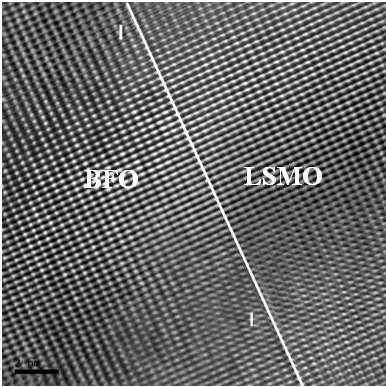Researchers integrate single-crystal BFO onto a silicon chip, open door to smart devices

(Phys.org) —Researchers from North Carolina State University have for the first time integrated a material called bismuth ferrite (BFO) as a single crystal onto a silicon chip, opening the door to a new generation of multifunctional, smart devices.
BFO has both ferromagnetic and ferroelectric properties, meaning that it can be magnetized by running an electric current through the material. Potential applications for BFO include new magnetic memory devices, smart sensors and spintronics technologies.
Integrating the BFO into the silicon substrate as a single crystal makes the BFO more efficient by limiting the amount of electric charge that "leaks" out of the BFO into the substrate.
"This work means we can now look at developing smart devices that can sense, manipulate and respond to data more quickly because it all happens on one chip – the data doesn't need to be relayed elsewhere," says Dr. Jay Narayan, John C. Fan Distinguished Chair Professor of Materials Science and Engineering at NC State and senior author of a paper describing the work.
The researchers also found that they can switch the polarity of the BFO's magnetic field with as little as four volts, which is comparable to the voltage needed in existing integrated circuits. This is a key to developing functional technologies because higher voltages and fields are impractical and use more energy, which could damage and disrupt electronic functions.
Similarly, the researchers found that a low-strength, external magnetic field – measured at 300 Oersted, a unit of magnetic field strength – can also switch the BFO's polarity. This is significant because external magnetic fields don't generate heat in the BFO, which could be important for some applications.
More information: "Interface Magnetism in Epitaxial BiFeO3-La0.7Sr0.3MnO3 Heterostructures Integrated on Si(100)," S.S. Rao, J.T. Prater, Fan Wu, C.T. Shelton, J.-P. Maria, and Jay Narayan, North Carolina State University. Nov. 7, 2013, Nano Letters. DOI: 10.1021/nl4023435
Abstract
We report on the heteroepitaxial growth of ferroelectric (FE)-antiferromagnetic (AFM) BiFeO3 (BFO) on ferromagnetic La0.7Sr0.3MnO3 (LSMO), integrated on Si(100) using pulsed laser deposition via the domain matching epitaxy paradigm. The BFO/LSMO films were epitaxially grown on Si(100) by introducing epitaxial layers of SrTiO3/MgO/TiN. X-ray diffraction, scanning electron microscopy, high-resolution transmission electron microscopy, X-ray photo absorption spectroscopy, and atomic force microscopy were employed to fully characterize the samples. Furthermore, we have investigated the magnetic behavior of this five layer heterostructure, in which a d5 system (Fe3+) manifested in FE-AFM BFO is epitaxially conjoined at the interface to a multivalent transition metal ion such as Mn3+/Mn4+ in LSMO. The temperature- and magnetic field-dependent magnetization measurements reveal an unexpected enhancement in magnetic moment and improved magnetic hysteresis squareness originating from the BFO/LSMO interface. We observe a stronger temperature dependence of HEB when the polarity of field cooling is negative as compared to positive field cooling. We believe such an enhancement in magnetic moment and magnetic coupling is likely directly related to an electronic orbital reconstruction at the interface and complex interplay between orbital and spin degrees of freedom, similar to what has previously been reported in the literature. Future work will involve the linearly polarized X-ray absorption measurements to prove this hypothesis. This work represents a starting step toward the realization of magneto-electronic devices integrated with Si(100).
Journal information: Nano Letters
Provided by North Carolina State University


















